Generative AI is transforming how we process unstructured data, such as articles, websites, and conversations. The true value lies not just in uncovering insights but in making them actionable. Integrating Generative AI into workflow automation allows businesses to enhance productivity, agility, and innovation across industries. With the right strategy, this powerful duo streamlines tasks, enhances customer interactions, and unlocks new opportunities, enabling businesses to stay ahead of the competition.
In this blog post, we’ll discuss practical use cases and why you should get started right away.
Gen AI and Workflow Automation: The Extended Duo

Many businesses are adopting Generative AI exclusively for the generation phase, creating insights, content, or recommendations, but still rely on human intervention to take the next steps. This limits the potential of AI, resulting in only a partial win. The real shift happens with gen AI workflow automation, where foundation models powering different modalities enable outputs to trigger actions across systems directly. For example, an AI-generated customer query response can be auto-routed, approved, and delivered without human intervention.
When positioned as a true duo, Generative AI and automation go beyond mere optimization; they significantly expand business capacity. With workflow automation powered by generative AI, the focus shifts from traditional knowledge-based tasks to interpreting AI-generated outputs and enabling workflows to act on these insights autonomously. This shift in approach accelerates decision-making, reduces errors, and drives measurable savings. The result is not just improved efficiency, but a scalable transformation that has far-reaching effects on strategy, innovation, and ROI.
How Gen AI Workflow Automation is Revolutionizing Traditional Limits?
The highly viral term “Generative AI for workflow automation” is not just a casual buzzword, it holds significant promise for businesses. No doubt, traditional automation offers efficiency, but automation powered by Gen AI is truly transformative. Let’s explore what it brings to the world and how it’s reshaping businesses from the inside out.
- Adaptive Process Intelligence: Generative AI workflow automation continually observes process flows, error patterns, and business metrics and then automatically adjusts branch logic, routing, or thresholds without manual reprogramming. This operational adaptability means fewer interruptions, lower maintenance burden, and faster response to changing conditions. For example, the “AdaptFlow” framework uses meta-learning to dynamically optimize workflows as new data comes in.
- Workflow Creation from Prompts: Instead of scripting or drag-and-drop builders, Gen AI workflow automation can generate full workflows from text prompts, interpreting business intents and stitching together integrations, API calls, and logic. The “Text2Workflow” research outlines how large language models convert natural language descriptions directly into executable processes, reducing manual design overhead.
- Knowledge-Infused Automation: Gen AI workflows co-opt enterprise knowledge bases, policies, past communications, and decision logs to guide automated tasks. That ensures the system doesn’t just “do” but “decides correctly” under context. In a real-world case study on expense processing, researchers combined generative AI + IDP + automation agents to cut process time by over 80%, reduce errors, and improve consistency.
- Continuous Optimization: Generative AI workflows don’t stay static or rule-based; they keep evolving with experience. Systems like “Cognify” apply hierarchical autotuning across prompts, operators, and orchestration layers to improve throughput, reduce cost, and lower latency. In tests, Cognify achieved up to 10× reduction in execution cost and 2.7× faster end-to-end latency.
- Multimodal Workflow Understanding: Gen AI workflow automation is not limited to structured data, in broad, it processes emails, scanned documents, images, voice notes, and more within one unified flow. This opens automation to complex operations like claims, audits, support tickets, or compliance checks. For the enterprise, that means dramatically fewer manual handoffs and broader coverage of formerly “manual only” tasks. (See frameworks for agentic, multi-modal systems evolving process automation.)
Real-World Use Cases of Gen AI Workflow Automation
In one of our blogs, we have discussed the use cases of generative AI across industries, whereas in this, we will explore more in-depth, unlocking the real-world use cases of generative AI for workflow automation.
1. Employee/Client/Vendor Onboarding Workflow

Generative AI can fully automate the employee onboarding workflow. After a new hire is officially confirmed, integrating Generative AI you can automate the process of writing a personalized welcome email, developing job-specific training materials, and setting up welcome meetings with respective seniors/members. Gen AI-enabled chatbots will be able to provide real-time responses to new hires’ questions, smooth onboarding transitions without HR involvement.
For example, companies like Deel use AI to personalize onboarding content and create training modules, enhancing the new hire experience while reducing manual HR effort. Architecturally, such systems integrate content-generation models (like GPT), natural language processing to understand queries, and workflow orchestration tools to sequence tasks automatically.
2. Customer Support Ticket Resolution Workflow

Have you ever wondered about Gen AI in customer support, even for end-to-end processes? So Here Generative AI is capable of executing all customer support tickets from creation through resolution. When a support ticket is created, generative AI can analyze and classify the issue, problem stated by users, generate the proper response, route it, if necessary, to the proper department, and deliver real-time status updates to the customer. Finally, once the issue is resolved, generative AI can automatically close the ticket and log the information for later analysis – all without human interaction.
Zendesk utilizes Generative AI-powered ticketing systems to improve scalability, accelerate agent onboarding, and address inconsistent brand invoices, thereby significantly reducing resolution times and enhancing customer satisfaction. These systems combine machine learning for classification, generative AI for response drafting, and integration with CRM systems for seamless automation.
3. Lead Nurturing & Sales Outreach Workflow

Leveraging Generative AI you can automate lead nurturing and outreach to potential customers fully. Generative AI can not only analyze incoming leads and segment audiences, but also write personalized emails, determine when to follow up based on engagement, and update customers’ CRM systems from time to time.
Platforms like n8n provide AI-driven templates for hyper-personalized email outreach, enabling automated management of the sales pipeline . Architecturally, these workflows leverage AI for content generation, predictive analytics for lead scoring, and automation tools for scheduling and CRM updates.
4. Invoice & Payment Processing Workflow

Now, you can pull your resources away from the tedious task of invoice and payment processing and invest more effort in monitoring. Invoice and payment workflows can now be fully automated with Gen AI capabilities and its integration in processes. How does it actually work? Let’s see: when a vendor submits an invoice, Gen AI can extract relevant details, match them against purchase orders, validate discrepancies, and initiate payments, all while updating financial records automatically.
HighRadius, for example, uses Generative AI in invoice processing to accelerate operations and reduce manual effort (The architecture typically combines Optical Character Recognition (OCR) for data extraction, machine learning for anomaly detection, and robotic process automation (RPA) for executing payments.
5. IT Incident Management Workflow

Generative AI is capable of automating IT incident management workflows, managing the entire incident process from detection to resolution. When a problem occurs, AI can analyze system logs, classify the incident, suggest remediation steps, notify stakeholders, and automatically update incident records.
BigPanda’s Advanced Insight platform uses generative AI to provide context-enriched incident summaries, accelerating resolution and reducing human intervention.
How to Get Started with Gen AI workflow Automation in Your Business?
Building, integrating, and automating workflows requires skilled expertise. At Rishabh Software, as a top-tier Generative AI development services company, we have experts who are well-versed in developing a systematic approach to GenAI-powered workflow automation. Let’s explore in detail:
Step 1: Identify Automation-Ready Processes
Start by mapping workflows where repetitive, data-driven, or knowledge-intensive tasks consume your team’s key effort. Look for an operation, process/workflow that highly depends on a generation part, like involving content creation, report generation, decision support, or customer interaction, areas where generative AI can add creativity or contextual understanding to make the entire flow automated.
As mentioned in the use case section, you can choose the right and most demanded operation for automation, including customer support ticketing, onboarding workflows, document generation, marketing campaign ideation, or code review.
You can rely on various tools that are used for process mining or task mining, such as SAP and Microsoft Power Automate Process Advisor, in order to visualize how workflows flow across systems. Take time for evaluation based on process/operations’ volume, complexity, business impact, and potential ROI from automation.
Before getting started, you can take a quick AI readiness assessment to check if your business is AI-ready.
Step 2: Choose the Right Platforms and Tools
Selecting the right tech stack serves many purposes, such as better security, scalability, and flexibility.
Leading options include:
- Azure AI services for deploying custom generative models integrated with enterprise data.
- UiPath for combining RPA with AI to build end-to-end intelligent automation pipelines.
- Custom LLMs or fine-tuned open models (like GPT, Claude, or Llama) for domain-specific workflows such as contract analysis or proposal generation.
You can explore more prominent platforms and tools as well with Rishabh Software and our AI experts, who possess deep tech stack experience and expertise.
Make sure that the chosen platform supports APIs, secure data handling, and prompt orchestration. You may also need vector databases (e.g., Pinecone, FAISS) for context retrieval and MLOps frameworks for lifecycle management.
Step 3: Pilot Projects
Start with a small-scale pilot in a high-value process to test feasibility and benefits before enterprise-wide rollout.
- Establish unambiguous success criteria: time saved, accuracy improvements, cost saved, or user satisfaction.
- Use connectors or APIs to incorporate GenAI models with your CRM, ERP, or other workflow systems.
- Emphasize human-in-the-loop validation, whereby agents or analysts assessing outputs produced by generative AI systems, will preserve quality and trust.
- Streamline future initiatives by documenting insights to improve prompt defining, model tweaking, and guiding frameworks for governance.
Step 4: Scale with Governance and Monitoring
Provide evidence of value for the organization-wide scaling of your previously delivered clients.
- Define the governance framework to be supported by AI, to incorporate the principles of data scarcity, bias detection, and model explainability.
- Closely track model performance, drift, and compliance as part of governance.
- Train employees in prompt engineering, AI ethics, and change management to drive governance.
- Establishing governance and oversight for innovation in AI will achieve expected coherence across diverse business units.
The integration of workflow automation using Generative AI enables faster decision-making, seamless operations, and further innovative pathways for businesses and their stakeholders.
Partner with Us to Redefine Your Business Productivity Through Gen AI Workflow Automation
Our Gen AI expert can help you;
- Streamline your business’s complex workflows with our Generative AI consulting and development services, designed to enhance decision-making, content creation, and task execution across departments.
- As an experienced AI/ML development company, we help you build AI models that understand your business inside out. We design context-aware systems that learn from your data, documents, and communication patterns, refining repetitive workflows with accuracy and intent.
- Break down silos by creating meaningful connections between apps, processes, and operations. From ERP to CRM to HRM, our custom integrations ensure that humans and AI systems work together seamlessly, not separately.
- Move fast, but with purpose. Our agile, iterative approach combines AI-driven testing and continuous learning to help your workflows evolve alongside your business.
Connect with us to explore how our Generative AI-driven solutions empower businesses to build self-learning, adaptive workflows that enhance productivity, improve accuracy, and enhance overall business agility.











 30 Min
30 Min


